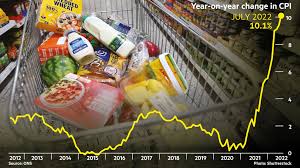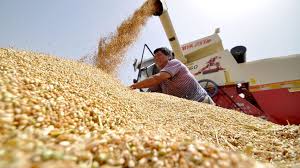What is the UK inflation rate and why is it so high?

London: The rate at which prices are rising has dipped slightly, but remains high despite predictions it would come down further.
The soaring cost of items like bread, cereal and chocolate mean that food prices are climbing at their fastest pace for nearly 45 years.
To help slow price rises, the Bank of England has increased interest rates 12 times in a row, to 4.5%.
Inflation is the increase in the price of something over time. If a bottle of milk costs £1 but £1.05 a year later, then annual milk inflation is 5%.
To come up with an inflation figure, the Office for National Statistics (ONS) keeps track of the prices of hundreds of everyday items in an imaginary “basket of goods”.
The basket is constantly updated to keep up with shopping trends, with the most recent changes adding frozen berries and removing Alcopops.
Each month’s inflation figure shows how much these prices have risen since the same date last year.
You can calculate inflation in various ways, but the main “headline” measure is the Consumer Prices Index (CPI).
The latest figure for CPI was 8.7% in the year to April, down from 10.1% in March.
Soaring food and energy bills have helped drive inflation up.
Oil and gas were in greater demand as life got back to normal after Covid. At the same time, the war in Ukraine meant less was available from Russia, putting further pressure on prices.
The war also reduced the amount of grain available, pushing up global food prices.
This effect was compounded in the UK in February by a shortage of salad and other vegetables, which took food inflation to a 45-year high.
Alcohol prices in restaurants and pubs also rose. Many people’s pay isn’t keeping up with rising prices.
The average weekly salary in the UK, excluding bonuses, was £603 in April, up from £598 in March, according to official figures.
But when you take inflation into account, regular pay actually fell by 1.3% in the three months to April, compared with the same period the year before.
Line graph showing private and public sector pay not keeping up with inflation
Unions say wages should reflect the cost of living and many workers have been striking over pay.
However, the government argues big pay rises could push inflation higher because companies might increase prices as a result.
The Bank of England has a target to keep inflation at 2%, but the current rate is well above that.
The traditional response to rising inflation is to put up interest rates.
This makes borrowing more expensive, and can mean some people with mortgages see their monthly payments go up. Some saving rates also increase.
When people have less money to spend, they buy fewer things, reducing the demand for goods and slowing price rises.
Businesses also borrow less, making them less likely to create jobs, and may cut staff.
In May, the Bank increased interest rates for the 12th time in a row, taking the main rate to 4.5%.
Chart showing how UK interest rates have changed (May 2023)
The next interest rate announcement is on 22 June.
But when inflation is caused by factors such as global energy prices, action from the Bank of England may not be enough to slow it down.
Lower inflation doesn’t mean prices fall. It just means they don’t rise as quickly.
When the Bank announced its May interest rate decision, it said headline inflation would “fall sharply from April”, while warning food price inflation was likely to fall back more slowly than previously expected.
It predicts inflation will drop to 5% by the end of 2023, rather than the 4% it had been anticipating.
The Office for Budget Responsibility (OBR), which assesses the government’s economic plans, previously predicted inflation would fall back to 2.9% by the end of the year.
In January, Prime Minister Rishi Sunak has said halving inflation by the end of 2023 was one of the government’s five key pledges.
Other countries have also been experiencing a cost-of-living squeeze.
Many of the reasons are the same – increased energy costs, shortages of goods and materials and the fallout from Covid.
The annual inflation rate for countries which use the euro was estimated to be 6.1% in May, down from 7% in April.
The European Central Bank has also been increasing interest rates to try to bring eurozone inflation down. Its benchmark rate is now 3.5%, the highest it has been for 22 years.
Inflation has also been falling in the US. It was 4% in the 12 months to May, down from 4.9% in April, the 11th consecutive monthly drop.
The US central bank has increased its key interest rate to 5.25%, up from near 0% a year ago – and the highest level since 2007.
However, it left rates unchanged in June, saying it wanted time to assess the impact of the rate rises made so far.





